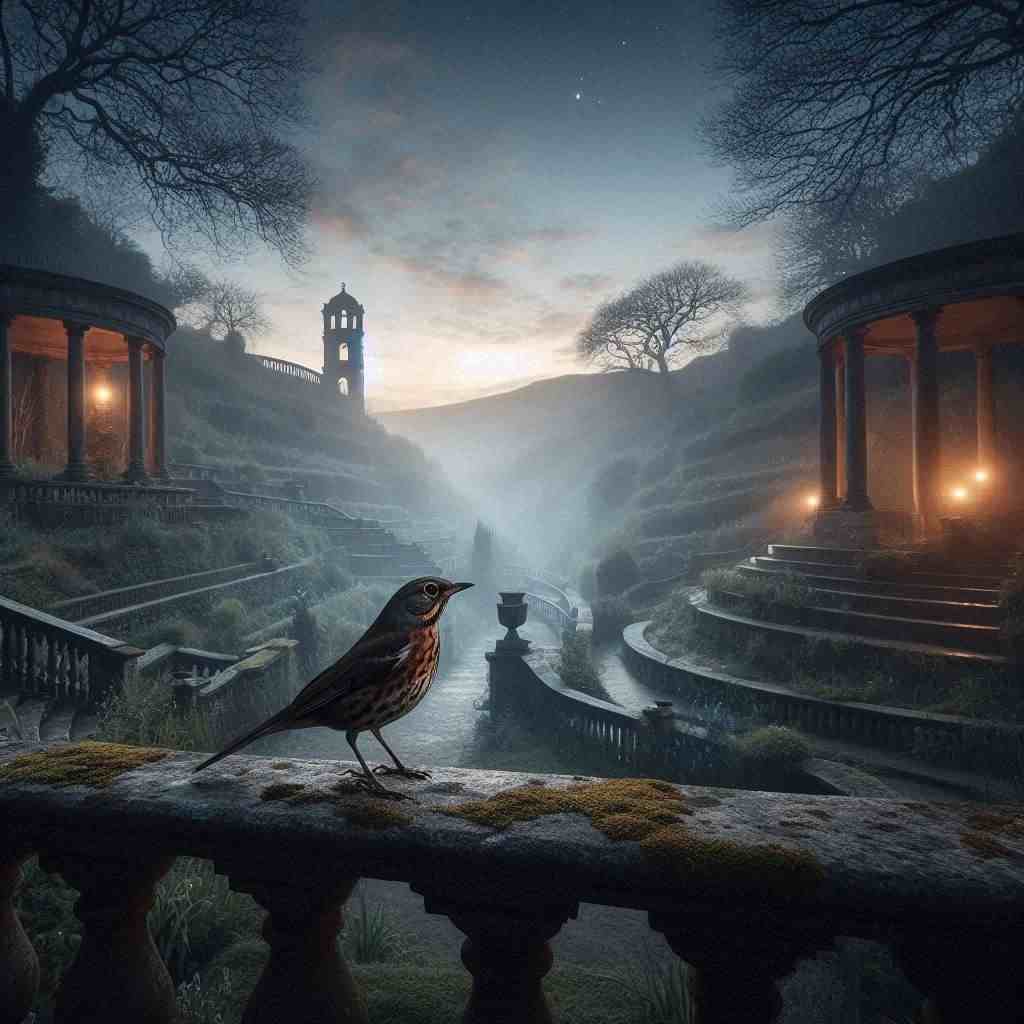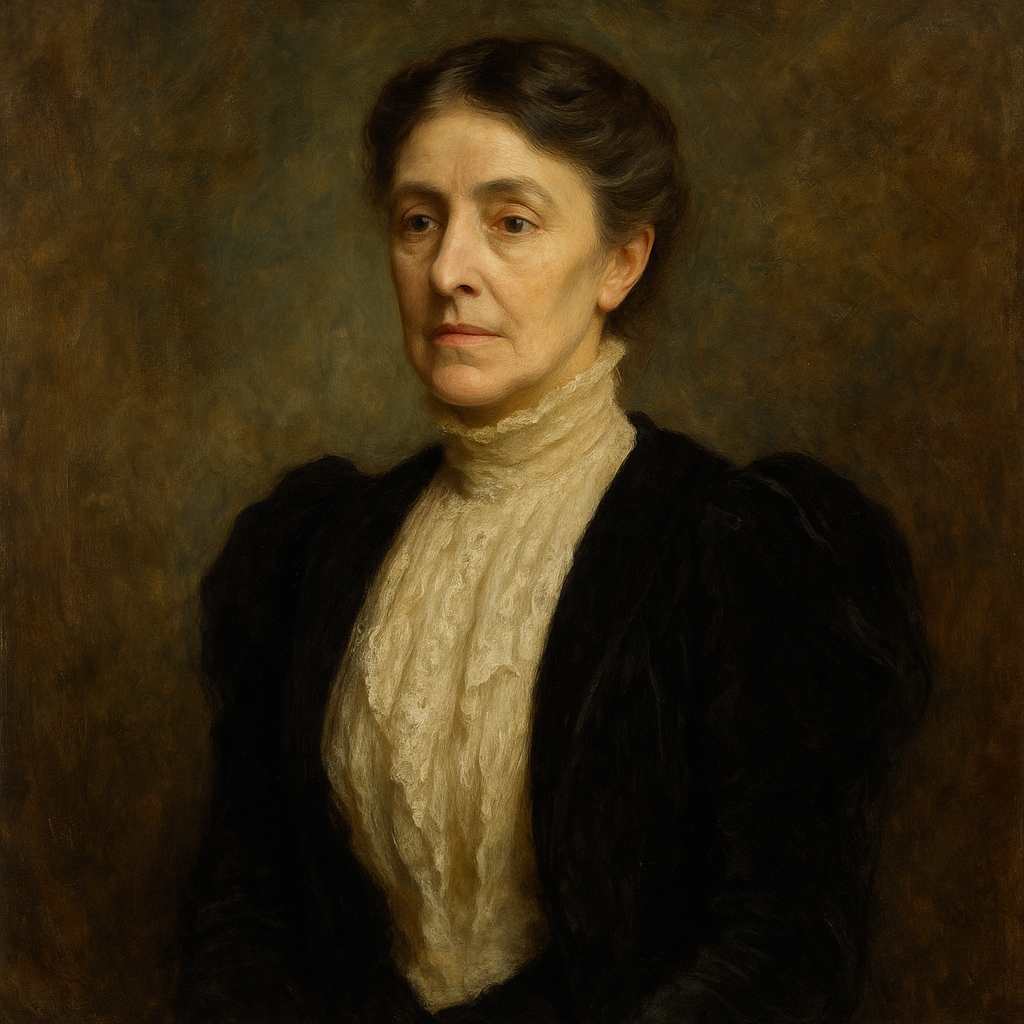A Thrush Before Dawn
Alice Meynell
1847 to 1922

A voice peals in this end of night
A phrase of notes resembling stars,
Single and spiritual notes of light.
What call they at my window-bars?
The South, the past, the day to be,
An ancient infelicity.
Darkling, deliberate, what sings
This wonderful one, alone, at peace?
What wilder things than song, what things
Sweeter than youth, clearer than Greece,
Dearer than Italy, untold
Delight, and freshness centuries old?
And first first-loves, a multitude,
The exaltation of their pain;
Ancestral childhood long renewed;
And midnights of invisible rain;
And gardens, gardens, night and day,
Gardens and childhood all the way.
What Middle Ages passionate,
O passionless voice! What distant bells
Lodged in the hills, what palace state
Illyrian! For it speaks, it tells,
Without desire, without dismay,
Some morrow and some yesterday.
All-natural things! But more—Whence came
This yet remoter mystery?
How do these starry notes proclaim
A graver still divinity?
This hope, this sanctity of fear?
O innocent throat! O human ear!
Alice Meynell's A Thrush Before Dawn
Introduction
Alice Meynell's "A Thrush Before Dawn" is a masterful exploration of the interplay between nature, time, and human consciousness. This early 20th-century poem exemplifies the late Victorian and early Modernist sensibilities, blending Romantic reverence for nature with a more introspective, philosophical approach characteristic of the emerging Modernist movement. Through its vivid imagery, complex structure, and profound thematic depth, Meynell's work invites a multifaceted analysis that reveals layers of meaning and artistic sophistication.
Structure and Form
The poem consists of five stanzas, each containing six lines with a rhyme scheme of ABABCC. This structured form, reminiscent of the sestet in a Petrarchan sonnet, provides a framework for Meynell's intricate exploration of the thrush's song. The regularity of the form contrasts with the otherworldly, almost transcendent quality of the content, creating a tension that mirrors the poem's thematic concerns.
Each stanza presents a distinct aspect of the thrush's song and its effect on the speaker, progressing from the immediate sensory experience to increasingly abstract and philosophical reflections. This structure allows Meynell to layer meaning and gradually expand the poem's scope from the particular to the universal.
Imagery and Symbolism
Meynell's use of imagery is both precise and evocative. The opening stanza immediately establishes the liminal setting with "this end of night," placing the reader in a moment of transition. The comparison of the thrush's notes to "stars" and "spiritual notes of light" creates a synesthetic effect, blending auditory and visual sensations to convey the ethereal quality of the bird's song.
Throughout the poem, Meynell employs a rich tapestry of symbols and allusions. The references to "The South, the past, the day to be" in the first stanza suggest that the thrush's song transcends temporal and spatial boundaries. This theme is further developed with mentions of "Greece," "Italy," and "Middle Ages," which serve to universalize the experience and connect it to a broader cultural and historical context.
The recurring motif of gardens, particularly in the third stanza, functions as a powerful symbol of innocence, growth, and the cyclical nature of life. By linking gardens with childhood and extending this imagery "night and day," Meynell creates a sense of timelessness and continuity that is central to the poem's exploration of human experience.
Themes and Philosophical Underpinnings
At its core, "A Thrush Before Dawn" grapples with the relationship between the ephemeral and the eternal. The thrush's song becomes a conduit for exploring profound philosophical questions about the nature of time, memory, and human consciousness.
The poem's treatment of time is particularly nuanced. Meynell juxtaposes the immediacy of the thrush's song with vast temporal expanses, from "centuries old" freshness to "Middle Ages passionate." This collapse of linear time suggests a Bergsonian concept of durée, or lived time, where past, present, and future coexist in the moment of perception.
Furthermore, the poem delves into the nature of memory and its role in shaping human experience. The reference to "Ancestral childhood long renewed" implies a collective or inherited memory that transcends individual experience. This idea is reinforced by the mention of "first first-loves, a multitude," suggesting that personal emotions connect us to a broader human legacy.
The Thrush as Metaphysical Poet
Meynell's portrayal of the thrush elevates the bird to the status of a metaphysical poet. The thrush's song, described as "Without desire, without dismay," embodies a pure, disinterested art that nonetheless communicates profound truths. This concept aligns with T.S. Eliot's notion of the objective correlative, where external objects or events express complex emotional states.
The final stanza's questions — "Whence came / This yet remoter mystery?" and "How do these starry notes proclaim / A graver still divinity?" — position the thrush's song as a vehicle for metaphysical inquiry. The bird becomes a mediator between the earthly and the divine, its song a revelation of "This hope, this sanctity of fear" that characterizes the human condition.
Modernist Elements and Literary Context
While rooted in the Romantic tradition of nature poetry, "A Thrush Before Dawn" anticipates several key aspects of Modernist literature. The poem's focus on subjective experience, its fragmentation of time, and its exploration of consciousness align with the concerns of early 20th-century writers like Virginia Woolf and James Joyce.
Moreover, the poem's self-reflexive quality, particularly evident in the final line's reference to the "human ear," demonstrates an awareness of the act of perception itself. This meta-poetic element, where the poem comments on its own creation and reception, is a hallmark of Modernist literature.
Meynell's work can be situated within the broader context of fin de siècle poetry, sharing affinities with the works of Gerard Manley Hopkins in its attention to the spiritual dimensions of nature, and with the early poems of W.B. Yeats in its blend of symbolism and natural imagery.
Language and Musicality
The poem's language is characterized by its musicality and precision. Meynell's choice of words often mimics the qualities she ascribes to the thrush's song: "Single and spiritual notes of light" exemplifies this through its sibilance and rhythm. The frequent use of enjambment creates a flowing, continuous quality that echoes the unbroken nature of the bird's pre-dawn performance.
Notably, Meynell employs a technique of accumulation, particularly in the second and third stanzas, where she lists qualities and images in a crescendo of meaning. This technique not only builds intensity but also reflects the overwhelming nature of the experience she describes.
Conclusion
"A Thrush Before Dawn" stands as a testament to Alice Meynell's poetic craft and philosophical depth. Through its intricate interweaving of form, imagery, and theme, the poem offers a profound meditation on the intersection of nature, art, and human consciousness. Meynell's thrush becomes more than a bird; it is a symbol of the transcendent power of art to connect the individual to the universal, the momentary to the eternal.
The poem's enduring relevance lies in its exploration of timeless questions about the nature of perception, the role of memory in shaping experience, and the human quest for meaning in the face of transience. As readers in the 21st century, we are invited to pause, like Meynell's speaker, and listen for the "spiritual notes of light" that might illuminate our own understanding of the world and our place within it.
In its fusion of Romantic sensibility, Symbolist technique, and proto-Modernist concerns, "A Thrush Before Dawn" occupies a unique position in the trajectory of English poetry. It serves as a bridge between literary epochs, embodying the best of 19th-century traditions while pointing the way toward the innovations of the 20th century. As such, it remains a rich text for scholarly analysis and a source of inspiration for contemporary poets grappling with the perennial challenges of capturing ephemeral experience in the enduring form of verse.
This text was generated by AI and is for reference only. Learn more
Want to join the discussion? Reopen or create a unique username to comment. No personal details required!



Comments
No comments yet. Be the first to comment!